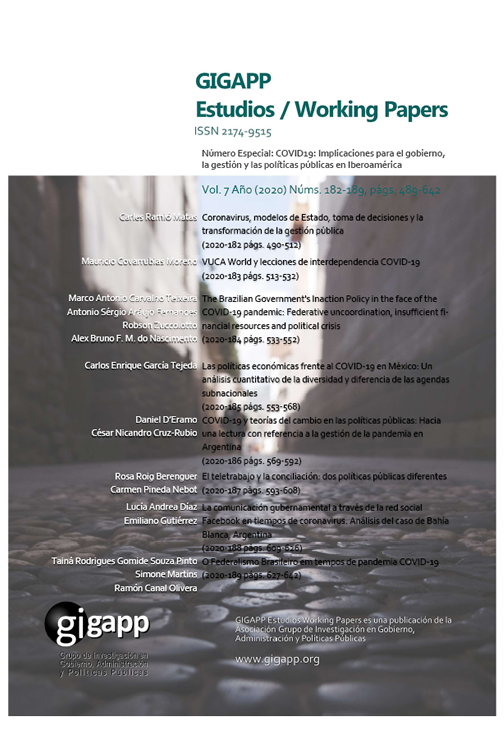El teletrabajo y la conciliación: dos políticas públicas diferentes
Resumen
El estallido de la crisis sanitaria producida por el Covid-19 ha disparado la demanda de teletrabajo a fin de poder mantener la actividad económica y evitar cualquier contagio por el virus. Al trabajar desde casa se evita el desplazamiento de las personas y se reduce considerablemente el contacto entre individuos. El teletrabajo se convierte, así, en la herramienta fundamental para frenar la exposición de las personas al coronavirus. Paralelamente se refuerza la percepción que el trabajo a distancia es una medida política que facilita la conciliación entre la vida familiar y laboral. Sin embargo, a lo largo de estas páginas se pretende demostrar que el teletrabajo es una política pública nacida para introducir una modalidad de trabajo, y, por tanto, no puede resolver el problema de la compatibilidad entre la vida laboral y familiar, a menos que se modifique su concepción actual y se acompañe de otras medidas políticas.
Descargas
Citas
Balbo, Laura. 1978. «La doppia presenza». Inchiesta, 32, 3-6. Consulta online el 8 de julio de 2020: https://cdn.atria.nl/epublications/fragen/BIDD-INCHIESTA.pdf
Banco de España 2020. El teletrabajo en España. Boletín Económico Banco de España, 2/2020. Consulta online el 8 de julio: file:///C:/Users/Usuario/Downloads/be2002-art13%20(4).pdf
Belzunegui-Eraso, Angel y Amaya Erro-Garcés. 2020. “Teleworking in the Context of the Covid-19 Crisis”. Sustainability, 12, 3662.
Benito-Osorio, Diana, Laura Muñoz-Aguado y Cristina Villar 2014. “The Impact of Family and Work-Life Balance Policies on the Performance of Spanish Listed Companies”. M@n@gement, 17: 4, 214-236.
Campillo, Inés. 2019. Políticas de conciliación de la vida laboral, personal y familiar en la Unión Europea. UNAF: Madrid.
Carrasquer, Pilar, Teresa Torns, Elisabeth Tejero y Alfonso Romero. 1998. “El trabajo reproductivo”, Pa-pers, 55, 95-114.
Castells, Manuel. 1997. La sociedad red. La era de la información, vol. 1. Madrid: Alianza.
Daly, Mary. 2011. “What adult worker model? A critical look at recent social policy reform in Europe from a gender and family perspective”. Social Politics, 18:1, 1-23.
Dente, Bruno y Joan Subirats. 2019. Decisiones públicas. Análisis y estudio de los procesos de decisión en políticas públicas. Barcelona: Ariel.
Farré, Lídia y González, Libertad. 2020. ¿Quién se encarga de las tareas domésticas durante el confina-miento? Covid-19, mercado de trabajo y uso del tiempo en el hogar. Blog nada-es-gratis. Consulta online el 8 de julio de 2020: https://nadaesgratis.es/admin/quien-se-encarga-de-las-tareas-domesticas.
Fernández Cordón, Juan Antonio y Constanza Tobío Soler. 2005. Conciliar las responsabilidades familiares y labores: políticas y prácticas sociales. Documentos de Trabajo 79/2005. Madrid: Fundación Alter-nativas.
Gálvez, Ana, María J. Martínez y Carmen Pérez. 2011. Telework and Work-Life Balance: Some Dimensions for Organisational Change, Journal of Workplace Rights, 16: 3-4, 273-297.
INE (2020a). “El teletrabajo en España y la UE antes de la Covid-19”, Boletín Informativo del Instituto Na-cional de Estadística, 02/2020. Consulta online 8 de julio de 2020: https://www.ine.es/ss/Satellite?L=es_ES&c=INECifrasINE_C&cid=1259952649680&p=1254735116567&pagename=ProductosYServicios%2FINECifrasINE_C%2FPYSDetalleCifrasINE
INE (2020b). “Movimiento Natural de la Poblacion (MNP). Indicadores Demográficos Básicos (IDB). Año 2019.”. Nota de prensa 3 de junio de 2020. Consulta online el 8 de julio de 2020: https://www.ine.es/prensa/mnp_2019_p.pdf
INE (2019). “Movimiento Natural de la Poblacion (MNP). Indicadores Demográficos Básicos (IDB). Año 2018”. Nota de prensa 19 de junio de 2019. Consulta online el 8 de julio de 2020: https://www.ine.es/prensa/mnp_2018_p.pdf
Lewis, Jane. 2001. “The Decline of the Male Breadwinner Model: Implications for Work and Care”. Social Politics: International Studies in Gender, State & Society, 8: 2, 152–169, https://doi.org/10.1093/sp/8.2.152
Lombardo, Emanuela. 2003. “La europeización de la política española de igualdad de género”, Revista Española de Ciencia Política, 9, 65-82.
Lowi, Theodore. 1972. “Four Systems of Policy, Politics, and Choice”, Public Administration Review, 32: 4, 298-310. doi:10.2307/974990
Nilles, Jack M. 1976. The Telecommunications-Transportation Tradeoff. Options for Tomorrow. Nueva York: John Wiley & Sons.
Nilles, Jack M. 1975. “Telecommunications and Organizational Decentralization”, IEEE Transactions on Communications, 23: 10, 1142–1147. Consulta online el 8 de julio de 2020: https://jala.com/Telecomm%20and%20Org%20Decentralization.pdf
OIT. 2019.Las plataformas digitales y el futuro del trabajo. Cómo fomentar el trabajo decente en el mundo digital. Ginebra: OIT. Consulta online el 8 de julio de 2020: https://www.ilo.org/wcmsp5/groups/public/---dgreports/---dcomm/---publ/documents/publication/wcms_684183.pdf
Parsons, Talcott. 1984. El sistema social. Madrid: Alianza.
Pérez de los Cobos Orihuel, Francisco y Javier Thibault Aranda, J. 2001. El teletrabajo en España, perspec-tiva jurídico laboral. Madrid: Ministerio de Trabajo y Asuntos Sociales.
Pérez Sánchez, Carmen. 2010. “El teletrabajo: ¿Más libertad o una nueva forma de esclavitud para los tra-bajadores?”, IDP. Revista de Internet, Derecho y Política, 11, 24-33. Consulta online el 30 de Junio de 2020: https://www.redalyc.org/articulo.oa?id=78817024008
Pérez Sánchez, Carmen y Ana Gálvez Mozo. 2009. “Teletrabajo y vida cotidiana: Ventajas y dificultades para la conciliación de la vida laboral, personal y familiar”, Athenea Digital, 15, 57-79. Consulta onli-ne el 8 de julio de 2020: file:///C:/Users/Usuario/Downloads/597-1488-3-PB.pdf
Quintanilla Navarro, Raquel Yolanda. 2017. “El teletrabajo: de la dispersión normativa presente a la nece-saria regulación normativa europea y estatal futura”, en Ministerio de Empleo y Seguridad Social de España (ed.): El futuro del trabajo que queremos. Vol. II. Madrid: Ministerio de Empleo y Seguridad Social.
Roig, Rosa, Cristina Aybar y José M. Pavía. 2020. “Gender Inequalities and Social Sustainability. Can Mod-ernization Diminish the Gender Gap in Political Knowledge?”, Sustainability, 12, 3143. Consulta on-line el 8 de julio de 2020: https://www.mdpi.com/2071-1050/12/8/3143/htm
Roig, Rosa. 2020. “Envejecimiento y cuidados: Un nuevo enfoque desde las políticas públicas”, GIGAPP Estudios Working Papers, 7: 157, 325-340. Consulta online el 8 de julio de 2020: http://www.gigapp.org/ewp/index.php/GIGAPP-EWP/article/view/189
Roig, Rosa. 2019. “El déficit de cuidado”, en Marrades, A. (coord.): Retos para el Estado constitucional del siglo XXI: derechos, ética y políticas del cuidado. Valencia: Tirant.
Roth, André-Noël (2008). “Perspectivas téoricas para el análisis de las políticas públicas: ¿de la razón científica al arte retórico”, Estudios Políticos, 33, Instituto de Estudios Políticos, 33, 67-91.
Sánchez Pérez, Carmen. 2010. “El teletrabajo: ¿Más libertad o una nueva forma de esclavitud para los tra-bajadores?”, Revista d’Internet, Dret i Política, 11. Consulta online el 8 de julio de 2020: fi-le:///C:/Users/Usuario/Downloads/Dialnet-ElTeletrabajoMasLibertadOUnaNuevaFormaDeEsclavitud-3424042.pdf
Subirats, Joan y Ricard Gomà. 1998. “Democratizacion, dimensiones de conflicto y políticas públicas en España”, en Gomà, Ricard y Joan Subirats (coords.): Políticas públicas en España. Barcelona: Ariel.
Subirats, Joan. 1993. Análisis de políticas públicas y eficacia de la Administración. Madrid: INAP.
Tatay, Carmen. 2020. “Teletrabajo, conciliación y genero: ¿mucho ruido y pocas nueces?”, en Monreal Bringsvaerd, Erik, Xavier Thibault Aranda y Ángel Jurado Segovia (eds.): Derecho del Trabajo y Nuevas Tecnologías. Valencia: Tirant.
Tobío Soler, Constanza. 2002. “Conciliación o contradicción: cómo hacen las madres trabajadoras”, Revis-ta España de Investigaciones Sociológicas, 97, 155-186.
Ushakova, Tatsiana. 2015. “El Derecho de la OIT para el trabajo a distancia: ¿una regulación superada o todavía aplicable”, Revista Internacional y Comparada de Relaciones Laborales y Derecho del Em-pleo, 3: 4, 74-92.
Derechos de autor 2020 Rosa Roig, Dra., Carmen Pineda Nebot (Autor/a)

Esta obra está bajo licencia internacional Creative Commons Reconocimiento-NoComercial-CompartirIgual 4.0.
Aquellos autores/as que tengan publicaciones con esta revista, aceptan los términos siguientes:
a. Los autores/as conservarán sus derechos de autor y garantizarán a la revista el derecho de primera publicación de su obra, el cuál estará simultáneamente sujeto a la Licencia de reconocimiento de Creative Commons Attribution-NonCommercial-ShareAlike 4.0 International (CC BY-NC-SA 4.0) que permite a terceros compartir la obra siempre que se indique su autor y su primera publicación esta revista.
Con esta licencia de acceso abierto, los lectores (usuarios) pueden:
- Compartir — copiar y redistribuir el material en cualquier medio o formato
- Adaptar — remezclar, transformar y construir a partir del material
Bajo los siguientes términos:
-
Atribución — usarios deberán dar crédito de manera adecuada, brindar un enlace a la licencia, e indicar si se han realizado cambios. Puede hacerlo en cualquier forma razonable, pero no de forma tal que sugiera que usted o su uso tienen el apoyo de la licenciante.
-
NoComercial — usuarios no puede hacer uso del material con propósitos comerciales.
-
CompartirIgual — Si remezcla, transforma o crea a partir del material, usuarios deben distribuir su contribución bajo la misma licencia del original.
-
Sin restricciones adicionales: los usuarios no pueden aplicar términos legales o medidas tecnológicas que restrinjan legalmente a otros de hacer cualquier cosa que permita la licencia.
b. Los autores/as podrán adoptar otros acuerdos de licencia no exclusiva de distribución de la versión de la obra publicada (p. ej.: depositarla en un archivo telemático institucional o publicarla en un volumen monográfico) siempre que se indique la publicación inicial en esta revista
c. Se permite y recomienda a los autores/as difundir su obra a través de Internet (p. ej.: en archivos telemáticos institucionales o en su página web) antes y durante el proceso de envío, lo cual puede producir intercambios interesantes y aumentar las citas de la obra publicada. (Véase El efecto del acceso abierto).



